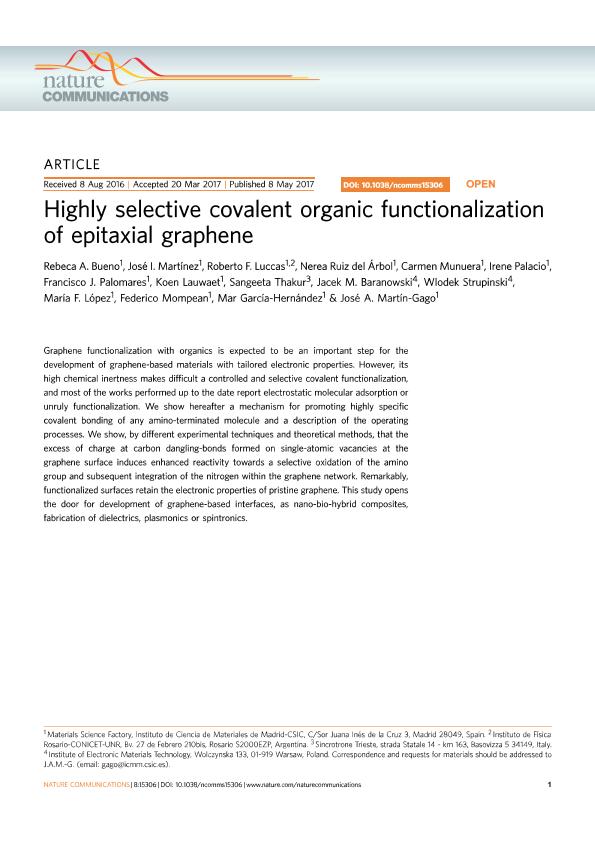Mostrar el registro sencillo del ítem
dc.contributor.author
Bueno, Rebeca A.
dc.contributor.author
Martínez, José I.
dc.contributor.author
Luccas, Roberto Fabián

dc.contributor.author
Del Árbol, Nerea Ruiz
dc.contributor.author
Munuera, Carmen
dc.contributor.author
Palacio, Irene
dc.contributor.author
Palomares, Francisco J.
dc.contributor.author
Lauwaet, Koen
dc.contributor.author
Thakur, Sangeeta
dc.contributor.author
Baranowski, Jacek M.
dc.contributor.author
Strupinski, Wlodek
dc.contributor.author
López, María F.
dc.contributor.author
Mompean, Federico
dc.contributor.author
García Hernández, Mar
dc.contributor.author
Martín Gago, José Ángel

dc.date.available
2018-07-27T17:11:32Z
dc.date.issued
2017-05
dc.identifier.citation
Bueno, Rebeca A.; Martínez, José I.; Luccas, Roberto Fabián; Del Árbol, Nerea Ruiz; Munuera, Carmen; et al.; Highly selective covalent organic functionalization of epitaxial graphene; Nature Publishing Group; Nature Communications; 8; 5-2017
dc.identifier.issn
2041-1723
dc.identifier.uri
http://hdl.handle.net/11336/53299
dc.description.abstract
Graphene functionalization with organics is expected to be an important step for the development of graphene-based materials with tailored electronic properties. However, its high chemical inertness makes difficult a controlled and selective covalent functionalization, and most of the works performed up to the date report electrostatic molecular adsorption or unruly functionalization. We show hereafter a mechanism for promoting highly specific covalent bonding of any amino-terminated molecule and a description of the operating processes. We show, by different experimental techniques and theoretical methods, that the excess of charge at carbon dangling-bonds formed on single-atomic vacancies at the graphene surface induces enhanced reactivity towards a selective oxidation of the amino group and subsequent integration of the nitrogen within the graphene network. Remarkably, functionalized surfaces retain the electronic properties of pristine graphene. This study opens the door for development of graphene-based interfaces, as nano-bio-hybrid composites, fabrication of dielectrics, plasmonics or spintronics.
dc.format
application/pdf
dc.language.iso
eng
dc.publisher
Nature Publishing Group

dc.rights
info:eu-repo/semantics/openAccess
dc.rights.uri
https://creativecommons.org/licenses/by-nc-sa/2.5/ar/
dc.subject
Graphene
dc.subject
Functionalization
dc.subject
Amino-Molecules
dc.subject.classification
Astronomía

dc.subject.classification
Ciencias Físicas

dc.subject.classification
CIENCIAS NATURALES Y EXACTAS

dc.subject.classification
Otras Ciencias Químicas

dc.subject.classification
Ciencias Químicas

dc.subject.classification
CIENCIAS NATURALES Y EXACTAS

dc.subject.classification
Nano-materiales

dc.subject.classification
Nanotecnología

dc.subject.classification
INGENIERÍAS Y TECNOLOGÍAS

dc.title
Highly selective covalent organic functionalization of epitaxial graphene
dc.type
info:eu-repo/semantics/article
dc.type
info:ar-repo/semantics/artículo
dc.type
info:eu-repo/semantics/publishedVersion
dc.date.updated
2018-07-26T13:58:17Z
dc.journal.volume
8
dc.journal.pais
Reino Unido

dc.journal.ciudad
Londres
dc.description.fil
Fil: Bueno, Rebeca A.. Instituto de Ciencia de Materiales de Madrid; España. Consejo Superior de Investigaciones Científicas; España
dc.description.fil
Fil: Martínez, José I.. Instituto de Ciencia de Materiales de Madrid; España. Consejo Superior de Investigaciones Científicas; España
dc.description.fil
Fil: Luccas, Roberto Fabián. Instituto de Ciencia de Materiales de Madrid; España. Consejo Superior de Investigaciones Científicas; España. Consejo Nacional de Investigaciones Científicas y Técnicas. Centro Científico Tecnológico Conicet - Rosario. Instituto de Física de Rosario. Universidad Nacional de Rosario. Instituto de Física de Rosario; Argentina
dc.description.fil
Fil: Del Árbol, Nerea Ruiz. Instituto de Ciencia de Materiales de Madrid; España. Consejo Superior de Investigaciones Científicas; España
dc.description.fil
Fil: Munuera, Carmen. Instituto de Ciencia de Materiales de Madrid; España. Consejo Superior de Investigaciones Científicas; España
dc.description.fil
Fil: Palacio, Irene. Instituto de Ciencia de Materiales de Madrid; España. Consejo Superior de Investigaciones Científicas; España
dc.description.fil
Fil: Palomares, Francisco J.. Instituto de Ciencia de Materiales de Madrid; España. Consejo Superior de Investigaciones Científicas; España
dc.description.fil
Fil: Lauwaet, Koen. Instituto de Ciencia de Materiales de Madrid; España. Consejo Superior de Investigaciones Científicas; España
dc.description.fil
Fil: Thakur, Sangeeta. Sincrotrone Trieste; Italia
dc.description.fil
Fil: Baranowski, Jacek M.. Institute of Electronic Materials Technology; Polonia
dc.description.fil
Fil: Strupinski, Wlodek. Institute of Electronic Materials Technology; Polonia
dc.description.fil
Fil: López, María F.. Instituto de Ciencia de Materiales de Madrid; España. Consejo Superior de Investigaciones Científicas; España
dc.description.fil
Fil: Mompean, Federico. Instituto de Ciencia de Materiales de Madrid; España. Consejo Superior de Investigaciones Científicas; España
dc.description.fil
Fil: García Hernández, Mar. Instituto de Ciencia de Materiales de Madrid; España. Consejo Superior de Investigaciones Científicas; España
dc.description.fil
Fil: Martín Gago, José Ángel. Instituto de Ciencia de Materiales de Madrid; España. Consejo Superior de Investigaciones Científicas; España
dc.journal.title
Nature Communications

dc.relation.alternativeid
info:eu-repo/semantics/altIdentifier/doi/https://dx.doi.org/10.1038/ncomms15306
dc.relation.alternativeid
info:eu-repo/semantics/altIdentifier/url/https://www.nature.com/articles/ncomms15306
Archivos asociados
